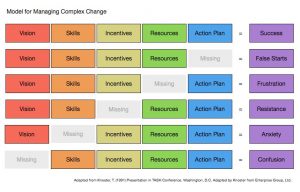By Christa Peters, Senior Manager, Instructional Design & Knowledge Management | 08/05/2021 |
We all know that person who says, “I hate change”.
I remember listening to a podcast years ago (trust me, I have unsuccessfully tried to find it again), where the host talked about how the “I hate change” statement is absurd. If people really hated change, how would one explain the fashion industry? No one would go to the hairstylist for a new color or style. The vacation, diet and exercise industries wouldn’t exist. No one would have an iPhone or seek out new technology.
The fact is people do like change. Positive change. Change they understand.
How does an organization, a leader or an individual contributor accomplish that?
Let me introduce you to the Lippitt-Knoster Model. 
You’ll see on the chart to the side of this article that there are five things that need to be included in any plan for change. A successful plan includes vision, skills, incentives, resources, and an action plan. When any of those things are missing or forgotten, the project will stall or fail.
In my opinion, the most crucial and often forgotten part of a plan is explaining the vision. I know. It seems crazy that the most basic item is often missing. I remember, early in my career, attending a bunch of meetings on a big program change. By the time it got to mobilizing my team, it didn’t occur to me that they were unaware of the project’s back story. They didn’t know why we’re doing the change. Without knowing the why, they weren’t bought in and were confused about what we were doing. The project was a disaster.
So how do you ensure that a big change isn’t a disaster?
People Who Manage People:
To be successful at implementing change, you need to create an environment where your team can raise concerns.
You also need to watch for behaviors indicated in the purple column on the chart. If you notice that your team member(s) are acting anxious, have a conversation about skills needed to implement the plan for change, and make a plan for them to gain those skills.
One last thing, create a task list for a project based on the Lippitt-Knoster Model. That will ensure you hit all the categories for quality change.
Individual Contributors:
I am going to let you in on a secret. The person who leads you is imperfect. They forget things. They have a lot going on. They need your help!
When you hear a plan for change, ask questions? Some good ones are “how will we know if this plan is successful after it is implemented? What resources will we have or need to implement this plan? How will this new idea benefit me or clients or others in the organization? If all else fails, pull out the Lippitt-Knoster model and make sure you check all the boxes. Your leader will thank you!
